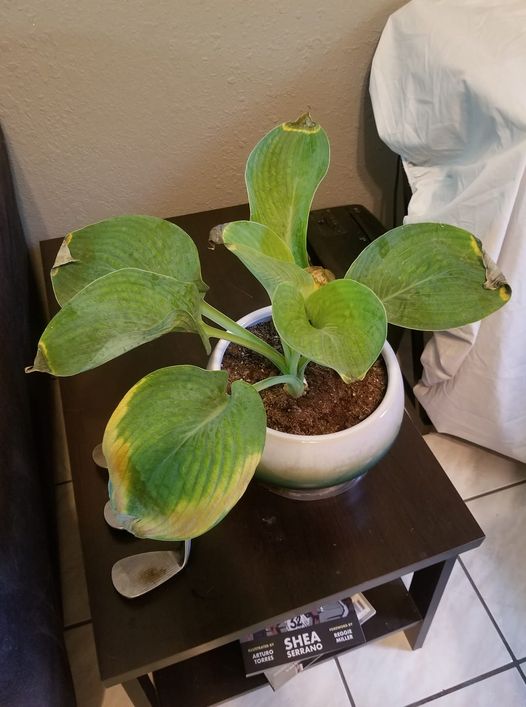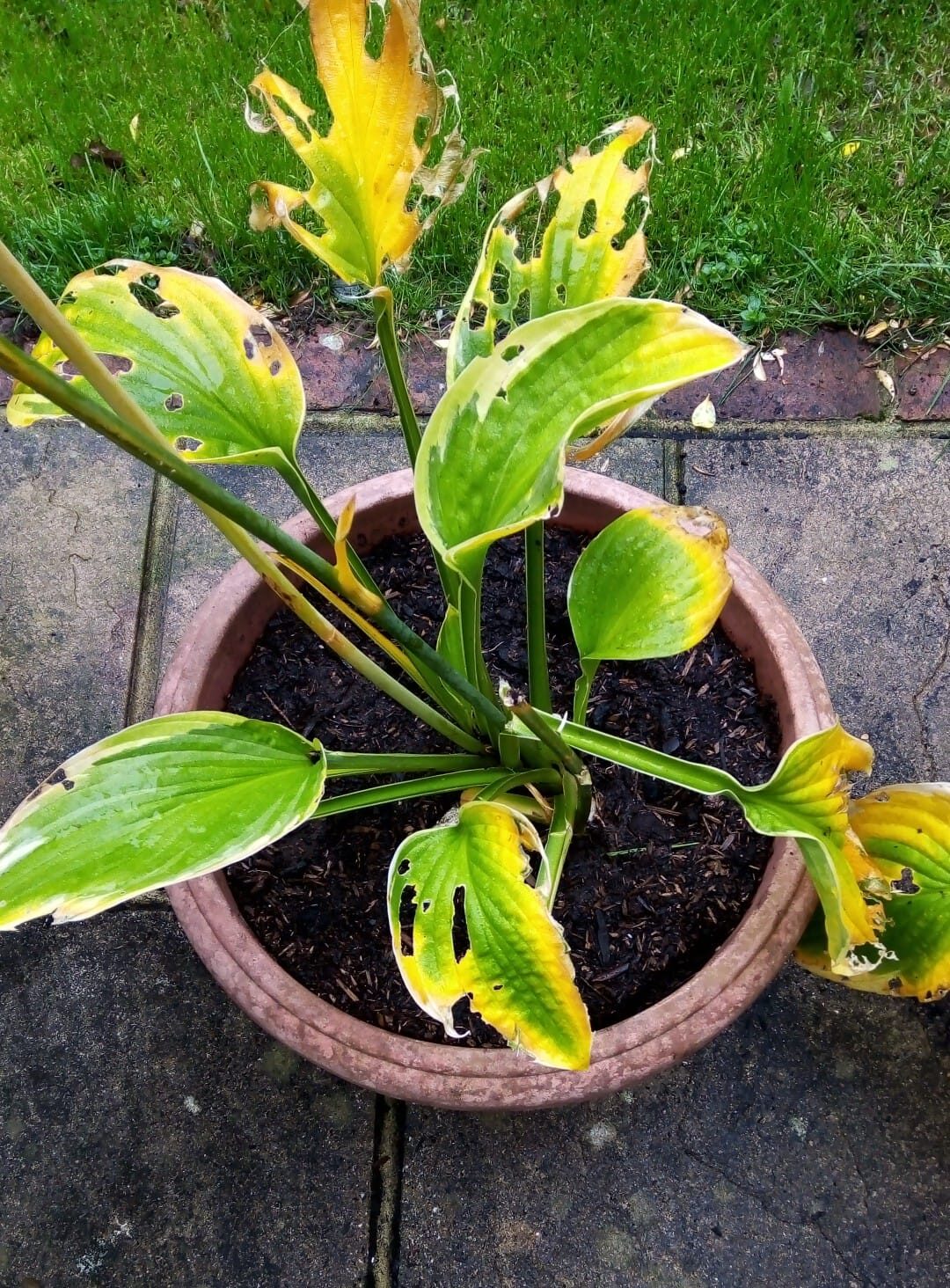Easy-growing Hostas can live more than 30 years, but improper conditions can decline their lifespan, turning their leaves yellow.
Leaves turning yellow are not necessarily a sign of death but severe conditions may result in death.
So before your favorite Hosta gives up on growing, diagnose the causes and fix them as soon as possible.
Table of Contents Show
5+ Reasons Behind Hosta Leaves Turning Yellow
After the growing season ends and the plant enters dormancy, leaves turning yellow are natural in Hostas.
The oldest leaves may also turn yellow due to aging. Apart from natural aging, some cultural factors can be culprits for yellowing the Hosta leaves.
Some Hostas, including Hosta ‘Sun Power,’ ‘Golden Prayers’/’Little Aurora,’ and ‘Prairie Fire’, are naturally yellow so you need not worry about them.
1. Improper Watering
Hosta is a drought-tolerant plant but also loves moist soil at the same time. Deep watering once a week is best for your Hosta plant.
However, if it is newly planted, you must water it daily whenever the soil feels dry.

Your Hosta may face yellowing even if you are watering correctly. It may be because of improper drainage and poor water quality.
Sometimes, yellowing may appear in spots that spread into the whole leaf afterward.
Solutions and Preventive Measures
- Water only when the top 2 inches of the soil feels dry. Leave the plant for some days if the soil is too soggy.
- Using a moisture meter will help you with proper watering.
- Always use a terracotta container with enough drainage holes.
- Follow the bottom watering method if the soil is extremely dry.
- Always use rain or distilled water as tapwater may include different unwanted chemicals.
- Use a pebble tray to maintain proper humidity.
2. Inappropriate Sunlight
Wide varieties of Hosta, like Blue Hosta, don’t prefer bright direct sunlight and love to be in partial shade.
Basically, Hostas can thrive under 6 hours of morning sun and a good afternoon shade.
Too low sunlight may also cause yellowing and lighter foliage due to slow photosynthesis.
Solutions and Preventive Measures
- Move your plant to the shaded location or east-facing window if it is in direct sunlight for too long.
- Provide dappling sunlight using sheer curtains if the plant is in a south-facing window.
- Dappling light is crucial to maintain variegation for variegated Hostas.
- If the foliage is light yellow and dull, provide it 5-6 hours of the morning sun.
- Provide 16 hours of artificial light with 8 hours of continuous darkness if natural light isn’t available.
3. Temperature Issues
Usually, Hosta thrives best in USDA zone 3-9 and can tolerate heat and cold. However, it may face issues if the weather is extremely hot or cold.
This hardy plant can tolerate about 28ºF during winter and summer temperatures up to 100ºF.
Also, when the temperature turns below 50ºF, there will be the end of its growing season with its leaves turning yellow.
Too high temperature may also cause yellowing, and gradually Hosta’s leaves turn dry and crispy with wilting.
Solutions and Preventive Measures
- If the plant is facing too high a temperature, move it to a location with a moderate temperature.
- Keep the plant away from cold drafts, heaters, and vents.
- Mist the plant to cool it during the hot summer.
- Cover the plant with frost blankets to protect it from extreme cold.
4. Incorrect Fertilization
Hostas prefer to be fed twice a month during spring and summer for better development.
Inadequate nutrition turns yellow leaf tips that gradually spread into whole leaves except veins without blooms.
Moreover, excessive salt and chemical buildup due to overfertilization also cause burnt foliage with gradual yellowing and browning.
Solutions and Preventive Measures
- Never let the granular fertilizer touch your Hosta’s foliage.
- Use balanced slow-release fertilizer with NPK value 10-10-10.
- Flush the overfertilized plant with distilled water and repot it in a new potting mix.
- Never fertilize your Hosta during winter as the plant goes dormant.
5. Wrong Soil
Organic and loamy type of soil is best for the plants like Hosta.
Hosta is a hardy plant that prefers well-draining, fertile soil with a pH of 6.5-7.5.
If you grow these plants in heavy clay and sandy soils, they will produce yellow leaves.
Solutions and Preventive Measures
- Use peat moss or cottonseed meals on the potting soil to lower the pH.
- Mix 1 part perlite, 1 part organic compost, and 2 part peat moss for homemade potting mix.
- All-purpose commercial garden soil will also work well for your Hosta.
- Use a pH meter to adjust soil pH accordingly.
Sometimes, when you repot your Hosta, it’s natural for its leaves to droop and turns yellow or brown.
The condition is called transplant shock. After some time, your plant will be back to normal.
6. Common Pests and Diseases
Besides external problems, your Hosta leaves may turn yellow due to several pests, diseases, and pathogenic invasions.
Diseases like root rot, stem rot, and many other fungal, bacterial, and viral pathogens may invade your Hosta, turning its leaves yellow.
Those pathogens are further spread by insects and pests such as black vine weevils, cutworms, leaf beetles, and many more.

Usually, root rot due to overwatering may be the reason behind leaves turning yellow in Hostas, resulting from poor air circulation.
However, if the leaves are turning yellow with brown margins, they hint at fungal infections. They may also invade areas wounded by insects and mites.
The leaves turning yellow due to pathogens can’t be revived, so you must discard the infected leaves of your Hostas to prevent the spread.
Solutions and Preventive Measures
- Isolate the infected plant to prevent the spread to other plants.
- Prune the infected parts and discard the whole plant if the infection is severe.
- Sterilize the pruning tools before and after pruning the Hostas.
- For root rot, flush the roots with distilled water and prune the decayed parts. Repot the plant in fresh potting mix.
- Never water the leaves infected by pathogens as it helps to spread them, and avoid mulching until the problem is solved.
- Use Proper pesticides, and fungicides every week or switch towards neem oil for safer treatment.
- Biological control is the best method to control insects and pests safely.
Should I Cut off Yellow Hosta Leaves?
As you can’t turn yellow leaves back green, all you can do is discard those yellowed leaves to save the plant’s energy.
You can prune those leaves off, as older leaves will never be young and green.
Take a pair of clippers and cut the dead or diseased leaves an inch off the ground.
And add a few inches of mulch on the topsoil to save the roots from winter after pruning Hosta.
Cut your Hosta back if you notice 25% or more parts dying. And cut back the Hostas in the late fall.
From Editorial Team
Yellowing is normal for store-bought Hostas!
When you buy Hostas from greenhouses or stores instead of growing them from seeds, they may turn their leaves yellow.
This is because you took it out of its comfort zone. Additional symptoms are drooping and wilting.
Wait until the plant adjusts to a new environment to see it return to normal.


